System You Will Use to Continuously Collect Stakeholder Concerns and Recommendations
Ultimate Guide to Stakeholder Management & Engagement
Best, Free, and Complete Guide for Conducting Project Stakeholder Engagement & Management
Published for Change Management Practitioners, HR, Program Leads, and Project Managers, this free guide provides you with everything you need to know about stakeholder relationship management. It includes step-by-step best practices for engaging with project stakeholders, and references change management stakeholder engagement matrix plans, examples, samples, and templates you can use for managing stakeholder engagement.
Understanding who your project stakeholders are and managing these change management stakeholders is one of the most important areas of project change management and needs to be conducted at the early stages of a project.
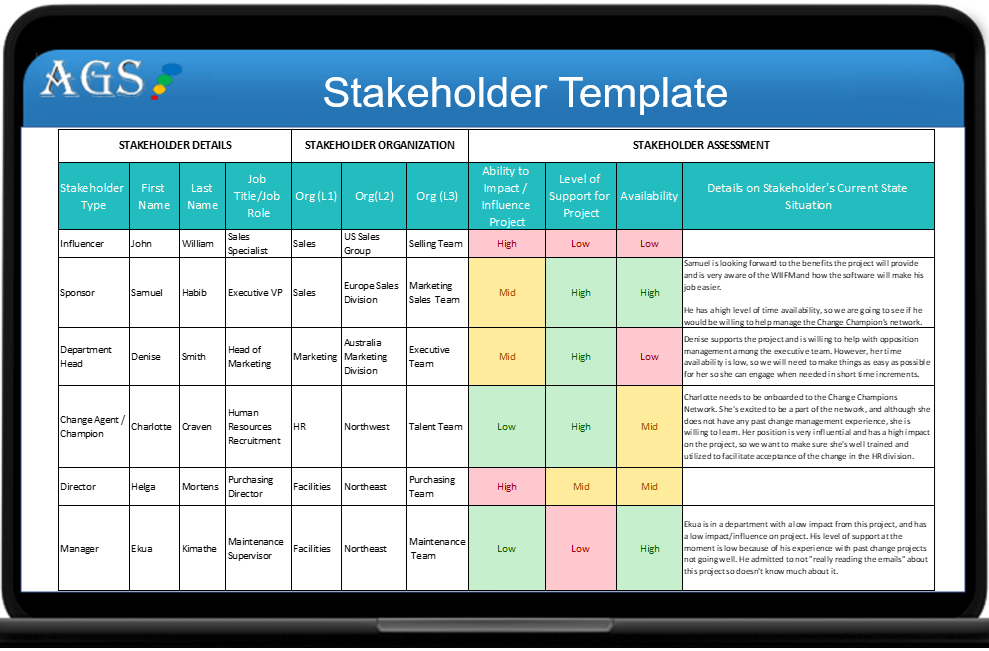
Sample change management stakeholder analysis template for managing stakeholder engagement.
Table of Contents – Everything You Need to Implement Your Stakeholder Management Strategy
Keep on scrolling down this page to read each section or click any link below to go directly to that section.
1. What are the Key Goals of Project Stakeholder Engagement?
2. What are the 3 Phases Needed for an Effective Stakeholder Strategy?
3. Who is This Project Stakeholder Engagement Framework Guide Designed for?
4. Key Questions from Project Managers and Change Leads
5. In Which Phase of Your Project Should You Start Stakeholder Analysis & Management?
6. What is Meant by Stakeholder Management? (Definition & Meaning)
7. What is the Main Purpose of Stakeholder Management and What are the Main Areas?
8. What is Stakeholder Engagement?
9. Do You Really Need a Stakeholder Engagement & Management Plan?
10. Importance of a Stakeholder Management Plan
11. Developing an Effective Stakeholder Management Plan (5 Key Steps)
12. Stakeholder Management Process (Step-by-Step)
13. Step 1: Stakeholder Management Mapping & Identification
14. Step 2. Stakeholder Assessment
15. Step 3. Stakeholder Engagement Strategy & Planning
16. Step 4: Implement Stakeholder Engagement Strategy
17. Step 5: Ongoing Stakeholder Management
18. Types & Role of Stakeholders in Project Management
19. Internal & External Stakeholders (Definition)
20. What Else Should You Know About Managing Stakeholders?
21. Different Levels of Sponsorship
22. Conclusion
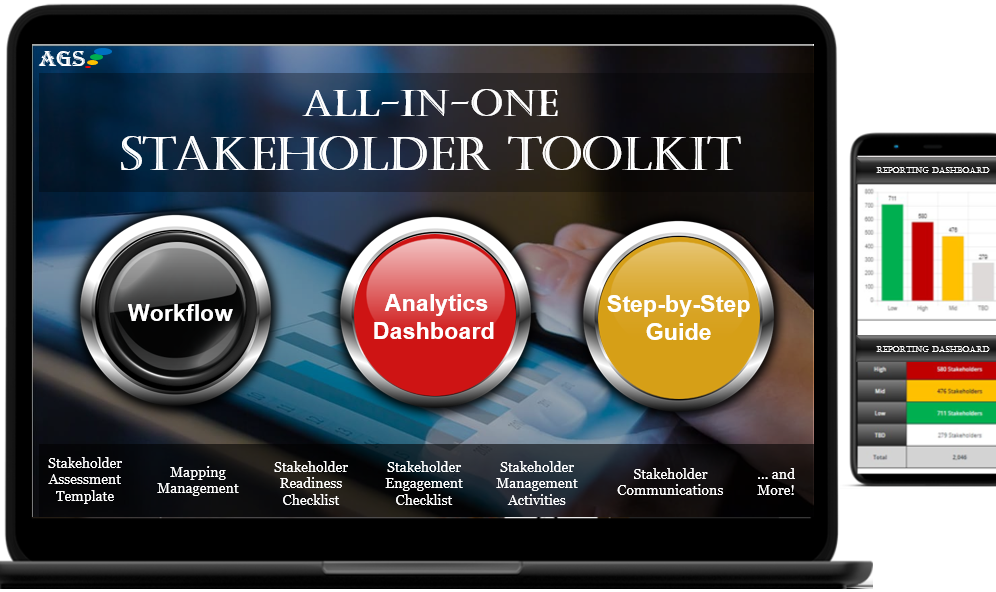
Stakeholder Mapping Tools (Reviews)
We recommend that you take the time to review each section below. They provide what you need to know for effective stakeholder relationship management, and reference project stakeholder management tools that you can use for your projects.
Also included are stakeholder engagement strategy examples. If you have obtained the AGS toolkit you can easily export stakeholder samples as a "stakeholder management plan example pdf" download for offline use.
Free Change Management Templates
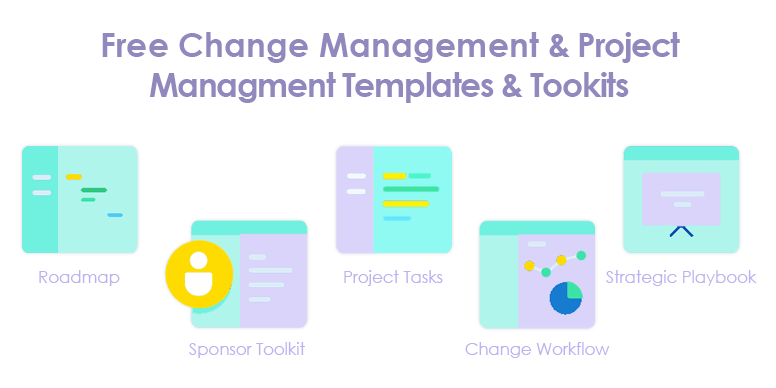
Get Your Free Change Management Templates Today
In addition, if needed, you can print out this whole guide to read and review it offline.
See Also: Software for managing stakeholder engagement
Questions about the stakeholder matrix or the stakeholder engagement plan templates reviewed in this guide? Please, reach out and let us know.
What are the Key Goals of Project Stakeholder Engagement?
The goal of managing key stakeholders in a project is to resolve or mitigate any resistance, leverage the talents of those willing to help, and drive overall support among stakeholders for the change project.
Why is it important to gain the support of those impacted by a change project?
According to a "stakeholder analysis in project management study" by Gartner that included over 6,500 employees and over 100 CHROs (Chief Human Resources Officers), transformational change has the best results when it happens in an environment where the organization and its executive stakeholders support the change and help to lead it.
The Garner stakeholder engagement model research found that 50% of change initiatives are clear failures and only 34% are clear successes. A big reason for this is that projects are often being driven at the executive level, but not enough is being done to engage with change management stakeholders at other levels to gain their support and buy-in.
Don't Miss: Stakeholder Engagement Map Tool
Executive project stakeholders that are more receptive to the project will often play an active role in supporting and advocating for the change, while project stakeholders that are resisting the change will often work to undermine the project.
As such, understanding the level of receptiveness for your change management project should be a part of your project stakeholder engagement matrix strategy, and your findings will need to be integrated into your stakeholder engagement plan.
For example, your plan should outline how you will engage with those stakeholders that oppose the project to mitigate their resistance and get them to embrace the project. More on this in the sections below.
Also, it's not only an organization's employees, managers, and executives that may be stakeholders of a change project. If a change is impacting vendors, suppliers, distributors, clients, or key customers, then they also could be considered key stakeholders for your stakeholder analysis change management activities.
Questions about the stakeholder matrix or stakeholder management plan template reviewed in this guide? Please, reach out and let us know.
What are the 3 Phases Needed for an Effective Stakeholder Strategy?
There are three key phases involved in a successful project stakeholder management program. The first phase is stakeholder mapping and assessment. This guide covers the final two phases, which are stakeholder engagement, followed by stakeholder relationship management.
- Phase 1 (Assess): Assessing and identifying stakeholders
- Phase 2 (Engage): Communicating with and interacting with stakeholders
- Phase 3 (Manage): Managing and maintaining successful long-term relationships with stakeholders.
Click here for a deep dive into the first phase: Conducting Effective Stakeholder Analysis, Mapping, & Assessments.
Your project stakeholder management strategy should begin with identifying which stakeholders are impacted by a change project. After identifying the key stakeholders in a project, the next step will be to assess each executive and senior stakeholder to learn how receptive they are to the project.
In order for your stakeholder engagement matrix to be effective, it should include not just how to engage non-supportive stakeholders, but also how to manage stakeholders that support the project to increase their level of support for the change.
See Also: Stakeholder Engagement Plan Examples, Samples, and Software
Once stakeholders are assessed, they need to be actively managed and engaged with, and it is recommended that you use a stakeholder engagement assessment matrix template for this.

Illustration: Key stakeholders in a project
This guide includes a wide range of project stakeholder engagement examples, but if you would like to provide more stakeholder management examples that can be included in this guide to help other project practitioner readers, please contact us.
1-on-1 Change Manager Coaching
Increase Your Change Management Successes & Expertise.

Have you been assigned to a change management project?
Get the best change management coaching. Discuss your plans and ensure you have not missed anything before delivering them to your stakeholders. Increase your change successes.
Safe environment. 1-on-1 change coaching. No question is too small. Ask me anything.
Find Out More | Schedule Your First Free Call
See also: AGS stakeholder engagement plan examples, samples & tools.
Do you have additional stakeholder engagement strategy examples you would like to share? Do you have feedback about engaging stakeholders in change management Please, reach out and let us know.
Who is This Project Stakeholder Engagement Framework Guide Designed for?
This stakeholder engagement model guide is designed for Change Practitioners, HR Professionals, Project Managers, Program Management Resources, Coaches, Business Analysts, IT, Trainers, Executives, Managers, Sponsors, Leaders, and anyone that needs to effectively manage stakeholders and formulate a successful stakeholder engagement plan.
As mentioned above, applying an effective stakeholder engagement model is a vital component of any project and organizational change management as it increases the success of your projects, programs, and your firm's business changes.
"I have been a Senior Change Management Lead for over 15 years and have delivered complex projects across top organizations including Intel, Apple, Cisco, HSBC, Goldman Sachs, Accenture, and Deloitte that have impacted thousands of employees and end-users. Throughout my tenure, I have discovered that following the best stakeholder management practices described below and the stakeholder management templates referenced in this help increase the success of change implementation by 131.5% on average."
Ogbe Airiodion
Senior Change Management Consultant
If you have any questions about using the stakeholder matrix outlined in this guide, reach out to let us know. A stakeholder matrix is essential for mapping, assessing, and managing all your project stakeholders throughout the duration of the project.
Key Questions from Project Managers and Change Leads
The AGS Change Management Editorial team receives frequently asked questions from project management leads and change managers. Key questions often asked about stakeholders include:
- What is stakeholder management?
- Who are stakeholders in a project?
- What are the best ways to create a stakeholder plan?
- Why are stakeholders important?
- Why is stakeholder engagement important?
- What is stakeholder engagement meaning?
- What is the role of stakeholders in project management?
- How do you plan stakeholder engagement?
This guide provides answers to all the questions above and move. But if you have additional questions or feedback about stakeholder management frameworks in general, please let us know.
Do you have additional stakeholder engagement strategy examples you would like to share? Do you have feedback about engaging stakeholders in change management Please, reach out and let us know.
In Which Phase of Your Project Should You Start Stakeholder Analysis & Management?
If you are following a specific stakeholder management plan model, such as the AGS Change Management Framework, you'll note that there are typically different change activities performed at different phases of a project.
For example, the AGS Change Model has five phases:
- Phase 1: Assess
- Phase 2: Develop
- Phase 3: Deploy
- Phase 4: Normalize
- Phase 5: Exit
So, at which stage should you conduct your change management stakeholder analysis? Your project stakeholder analysis should be done during Phase 1 (Assess Phase) in alignment with your other change assessments. During this 1st phase, your stakeholder analysis in project management will be focused on understanding your stakeholders.
Developing your stakeholder management plan will come in Phase 2 (Develop Phase), and you will execute that plan and actively manage your stakeholders in Phase 3 (Deploy Phase) and Phase 4 (Normalize Phase).
Once stakeholders from impacted groups are assessed, you'll be actively managing those stakeholders and engaging with them throughout the project and beyond the "go-live" date through to the change normalization phase using your stakeholder matrix template.
A key reason to use a stakeholder engagement assessment matrix is that such a template allows you to manage all aspects of your project stakeholder activities and ensures that you don't drop any balls. If you are very good with Excel, you can build a stakeholder management matrix from scratch. In addition, or alternatively, you can leverage the AGS stakeholder engagement assessment matrix which contains best-in-class seamless columns for capturing all the required data, and also includes analytics samples for all aspects of your stakeholder engagement activities.
If you are building the stakeholder management matrix by yourself, you'll want to ensure you include columns for gathering the who, what, when, how, and why of an effective stakeholder management strategy.
Don't Miss: Stakeholder engagement plan template
Do you have more examples and feedback on best practices for conducting change management stakeholder analysis in project management? Please, reach out to us.
Illustration: Stakeholder Chart and Engagement Reporting Dashboard
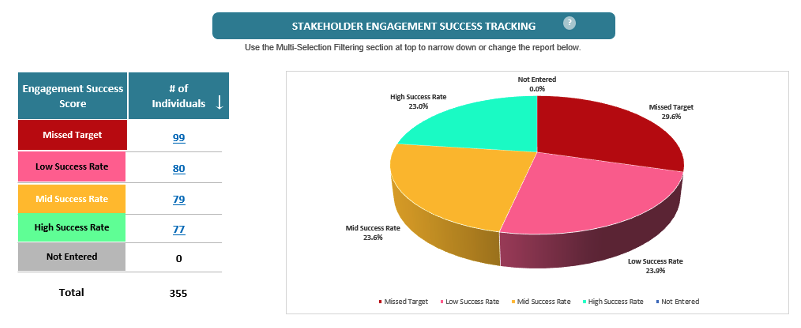
AGS Stakeholder Management Tools for Your Stakeholder Strategy
Using stakeholder engagement tools is essential for managing and tracking all aspects of your stakeholder engagement training management and helps to facilitate effective stakeholder engagements. Check out the AGS stakeholder management system, including a stakeholder chart dashboard to see if it is something that you can use to guide your stakeholder strategy communication and stakeholder management.
What is Meant by Stakeholder Management? (Definition & Meaning)
Stakeholder management is the set of tasks that you perform to identify and manage key stakeholders in project management, including managers, business leaders, employees, and other stakeholder groups that will be impacted by a change initiative. Leaders and managers are often referred to as "key stakeholders."
Understanding the mean of stakeholder management is very important as it is often confused with stakeholder engagement which is a component of the end-to-end process of managing stakeholders.
Managing stakeholders includes all activities including engaging, tracking, monitoring, and supporting project stakeholders.
Your list of stakeholders for your project stakeholder management and engagement template will include:
- People & groups who will be impacted by a change project
- People & groups who will be influenced by a change project
- People & groups who may hold influence over a change project
If you have other examples and definitions for the often asked "stakeholder management meaning" question, please contact us to let us know.
Stakeholder Engagement Mapping is a Critical Step for a Successful Change Project. Check out the AGS stakeholder engagement plan templates .
Do you have additional stakeholder management strategy examples you would like to share? Do you have feedback about other stakeholder engagement strategy templates you have used that you'll like to share with other change and project practitioners? Please, reach out and let us know.
What is the Main Purpose of Stakeholder Management and What are the Main Areas?
The main purpose of stakeholder relationship management is to ensure the success of a project or business initiative. Stakeholders play a key role in whether a change will be successful. If lots of stakeholders embrace the change, then the success increases. If most stakeholders resist the change, then the business initiative will most likely fail.
And so, an effective project stakeholder management program's purpose is to engage with stakeholders to increase the success of a change.
There are generally four areas that stakeholder relationship management encompasses:
1. Identifying stakeholders in project management
2. Assessing each stakeholder's influence, support, resistance, and willingness to help as it relates to the project, and entering the information in your stakeholder engagement assessment matrix, and then developing your stakeholder management strategy & plan based on your findings
3. Implementing your stakeholder plan and engaging with stakeholders
4. Implementing your stakeholder communication plan to relay change activities/news/requirements to identified stakeholders
Poor stakeholder management is one of the reasons why projects fail, and so it is important to implement an effective stakeholder engagement roadmap and stakeholder strategy.
Contact us and let us know if you have more "what is the purpose of stakeholder management examples" that you would like to see listed in this guide to help other project and program managers.
Illustration: Sample Stakeholder Management Tool
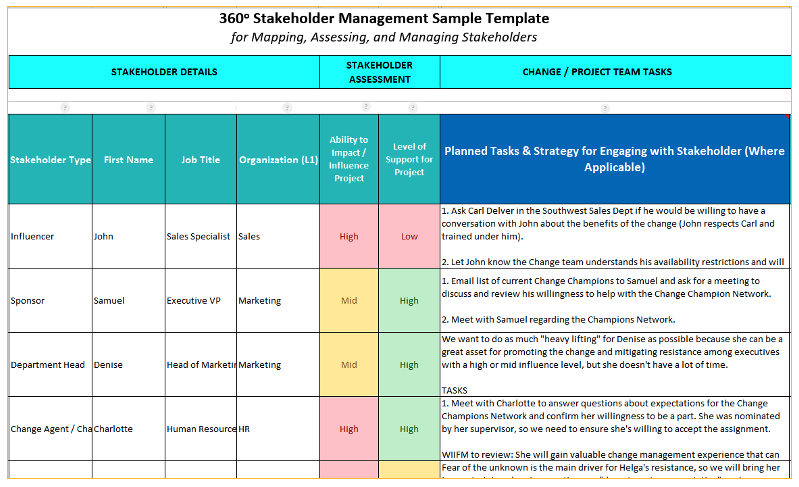
FREE Change Management Templates (Excel, PDF, PPT)
Get Free Templates Today
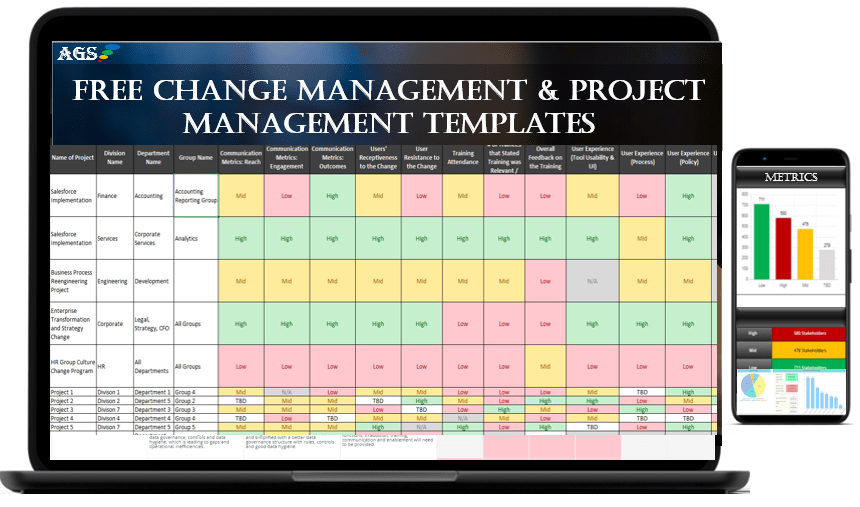
Get Your Free Change Management Templates Today
See also: Stakeholder Management Examples & Toolkit. The AGS toolkit includes stakeholder management plan examples, samples, and matrix for your needs.
Do you have additional stakeholder management strategy examples you would like to share? Do you have feedback about other stakeholder engagement strategy templates you have used that you'll like to share with other change and project practitioners? Please, reach out and let us know.
What is Stakeholder Engagement?
Stakeholder engagement is part of the stakeholder management process and involves the set of tasks and activities that you need to conduct to effectively engage with your stakeholders to drive the change forward. A stakeholder engagement strategy outlines the who, what, how, why, and when.
What types of stakeholder engagement activities might be needed?
Project stakeholder engagement activities can vary widely according to the stakeholder, their level of impact on the project, and their level of support or opposition.
Change management is about the people going through the transition. So, their feelings about a change and their level of ability to negatively or positively impact your project will drive your engagement strategy.
Below are two sample stakeholder engagement activities examples.
(1) Project stakeholder engagement activities example:
Samuel is a sponsor, meaning he is a stakeholder that is also a sponsor of the change. During his stakeholder assessment, he indicated he would be interested in leading the Change Champions Network.
His engagement will involve giving him the coaching support he needs to fulfill his role, as well as setting him up with the list of Change Champions, necessary communications templates, software tools, etc.
(2) Project stakeholder engagement activities example:
Jan is an influencer, meaning others in her department tend to follow her lead. She is unhappy about the disruption that the change is causing for her "already too busy" team.
Her engagement will involve enlisting the help of a colleague or superior that Jan respects to help her understand the benefits of the change to her department and her personally. The goal is to resolve her concerns, so she is on board with the project.
As you can see from the project stakeholder engagement activities examples above, engagement activities are specific to the stakeholder. However, 0ne activity that everyone will need as part of their engagement strategy is communications. Read more here: creating the best stakeholder communication plan for your project.
It's essential as the project progresses, to keep key project stakeholders engaged and updated on the progress of the implementation, as well as coach them to support change management and project implementation activities. You should also ensure that you are tracking stakeholder management activities through to completion using a stakeholder engagement tool.
All the above will need to be integrated into your stakeholder management strategy. More on this below.
See also: stakeholder management examples, templates, tools.
Illustration: AGS stakeholder relationship management Template for planning engagement tasks
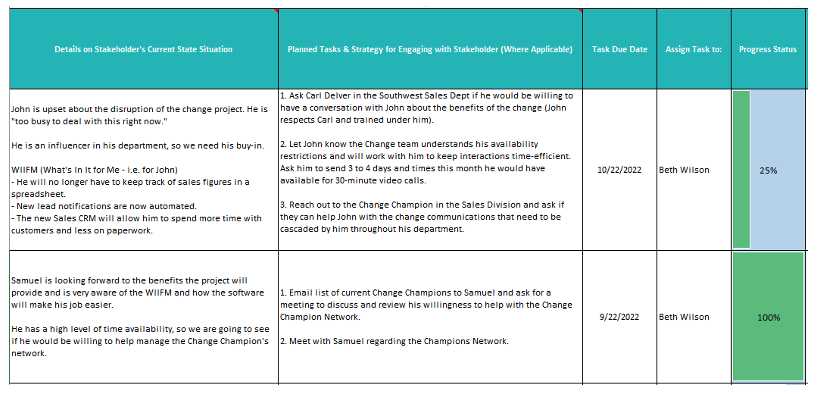
Stakeholder engagement examples and checklist
Use the above stakeholder template for tracking your stakeholder management training activities. Read more here: AGS Stakeholder Engagement Examples, Checklist, and Toolkit.
Do you have additional stakeholder management plan example pdf samples you would like to share? Do you have feedback about other stakeholder engagement plan template Word templates you have used that you'll like to share with other change and project practitioners? Please, reach out and let us know.
Do You Really Need a Stakeholder Engagement & Management Plan?
A project stakeholder management plan is a structured document that outlines your stakeholder strategy, stakeholder mapping, and project activities that will be implemented to engage your project stakeholders, including leaders and managers that are impacted by a project or a business change.
But do you really need to take the time to develop a stakeholder engagement plan? Are there stakeholder engagement templates that you can use to maximize your stakeholder management planning and activities?
The answer to both is, "Yes!"
If you want your stakeholder engagement to be meaningful and accomplish a specific objective, then you need to take the time to map it out. You'll be mapping out both individualized and shared stakeholder engagement strategies (more on this below).
There are stakeholder engagement plan template tools you can use to make stakeholder engagement planning easier for you, such as the AGS 360° Stakeholder Management Toolkit, which includes a template for managing stakeholder data and an interactive cross-project reporting dashboard.

Stakeholder engagement plan templates and stakeholder chart.
See also: AGS stakeholder engagement plan examples, samples & tools. The AGS tools include stakeholder management plan examples, samples, and template matrix for your needs.
Do you have additional stakeholder management plan example pdf samples you would like to share? Do you have feedback about other stakeholder engagement plan template Word templates you have used that you'll like to share with other change and project practitioners? Please, reach out and let us know.
Importance of a Stakeholder Management Plan
Before going further, let us address the question "why is a stakeholder engagement plan important?" This is a question that is asked often by many project managers and change management practitioners.
Applying an effective stakeholder engagement framework is very important because stakeholders are in a position to increase, block, or decrease the success of the project. If stakeholder groups are resistant to the change, this will have a negative impact on the implementation of the project. If, on the other hand, they are very supportive of the change, then the probability of project success is greatly increased.
As such, it is critical to engage and manage all stakeholders to ensure that they provide continual buy-in and support for the change throughout the implementation.
Something else you should note before we provide an overview of how to create your stakeholder management plan is that primary, key, and critical stakeholders are needed to play key change management roles to help increase end-user adoption of the change.
For example, we might need primary stakeholders to cascade or waterfall down communications to their respective groups and direct reports. In addition, when we need to train impacted end-users, we often will need the help of our key leadership stakeholders (also referred to as primary stakeholders) to remind their employees to attend the training sessions.
These are just a few examples of the importance of stakeholder management in project management.
And this brings us to the importance of having a stakeholder management plan and strategy, as well as how to develop your own stakeholder engagement strategy.
See also: AGS stakeholder engagement plan examples & templates.
Do you have additional stakeholder management plan example pdf samples you would like to share? Do you have feedback about other stakeholder engagement plan template Word templates you have used that you'll like to share with other change and project practitioners? Please, reach out and let us know.
Developing an Effective Stakeholder Management Plan (5 Key Steps)
To develop an effective stakeholder management plan, there are five key steps you need to take.
1. The first step is to identify the universe of potential stakeholder groups. This step is often referred to as stakeholder identification.
2. The second step is to assess each stakeholder and stakeholder group and their support or resistance to the change, along with other factors and include them in your stakeholder engagement map.
3. The third step is creating your stakeholder engagement strategy. This will consist of shared activities as well as individualized engagement.
4. The fourth step is to engage these stakeholders and prepare them for the change.
5. And the final step is continual engagement and management of these stakeholders throughout the strategic (planning) and tactical (execution) phases of the project.
Click any of the links below, or keep on scrolling down this page, for an overview of each of these five critical steps for your stakeholder management approach.
- Step 1: Stakeholder Management Mapping & Identification
- Step 2. Stakeholder Assessment
- Step 3. Stakeholder Engagement Strategy & Planning
- Step 4: Implement Stakeholder Engagement Strategy
- Step 5: Ongoing Stakeholder Management
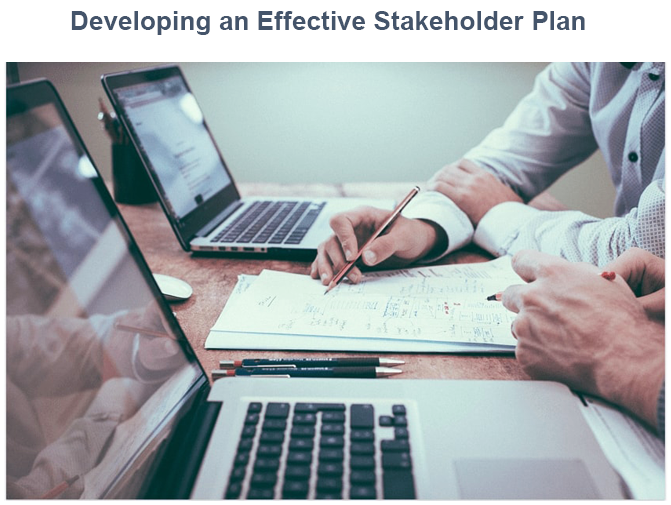
As mentioned above, having a defined and planned stakeholder management plan will help increase your engagement and management of the various types of stakeholder groups including primary stakeholders and key stakeholders, as well as internal and external stakeholders. All of these groups are generally referred to as project stakeholders.
The 5 essential steps for engaging & managing project stakeholders are discussed in detail in the sections below.
Stakeholder Management Process (Step-by-Step)
Step 1: Stakeholder Management Mapping & Identification
The first step in the stakeholder management process is to identify all potential leaders, senior managers, employees, or external stakeholders that have or might have a stake in the project.
Unless you have a very small organization, you most likely will not be including every single impacted individual on the list of stakeholders being managed. Going through individual stakeholder management with thousands of people would be tall order. Thus, for most projects, a representative group of stakeholders is included as part of your stakeholder management strategy
You want to include people at all levels of an organization because leaders and managers are impacted differently than employees. If you leave out the representation of an important group, you could end up with unexpected opposition from those groups that you didn't assess for resistance, support, impact on the project, etc.
Also, it's not only employees that may be stakeholders of a change project. If a change is impacting vendors or large customers, then they also could be considered stakeholders.
Determining the scope of people and groups you include when analyzing and managing stakeholders would be something you'd want to determine when doing your project assessment.
To obtain your list, you can work with members of the program team, including project managers, program leads, subject matter experts (SMEs), primary sponsors of the project, and other key project resources.
When meeting with these people, inform them that you are conducting a stakeholder identification assessment, and are looking to identify managers and stakeholder groups who will be impacted by the project.
You should also mention to them that you are looking to also identify senior managers and executives of impacted organizations who are considered critical internal stakeholders.
As you conduct your stakeholder identification and information gathering, it's important to stay organized and use a tool that allows for team collaboration. You can document your findings in your AGS Stakeholder Management Matrix Template, which fulfills these needs.
Click here to obtain your copy: #1 Stakeholder Engagement Framework & Management Toolkit.
Illustration: AGS Stakeholder Template for Assessing & Managing Project Stakeholders
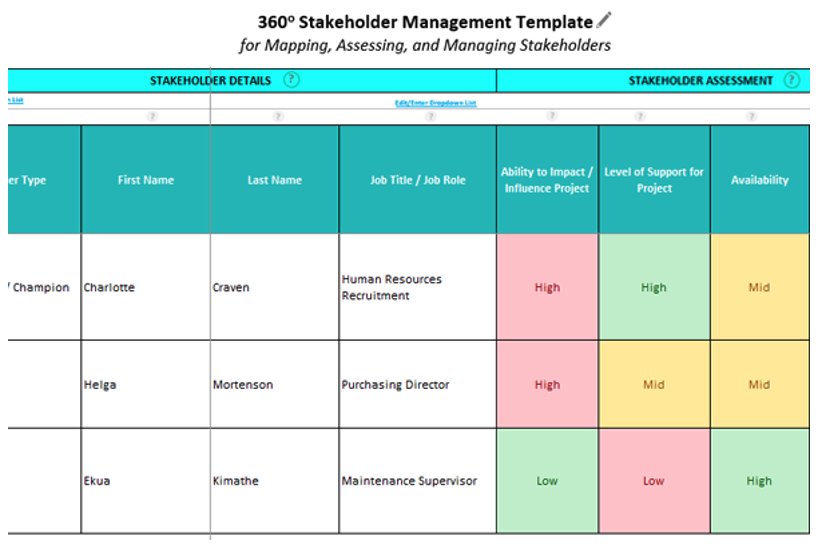
The AGS 360° Portfolio stakeholder management software includes a ready-to-use stakeholder identification and mapping template, as well as defined fields that are critical to effective stakeholder management in project management.
You won't have to reinvent the wheel. You start with a layout of columns modeled on change management best practices and are guided by informative tooltips throughout the platform. You also have the flexibility to add columns, hide columns, and move columns where you like.
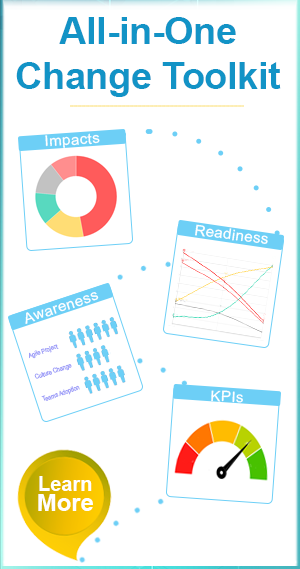
Illustration: AGS Stakeholder Toolkit – Interactive Cross-Project Reporting
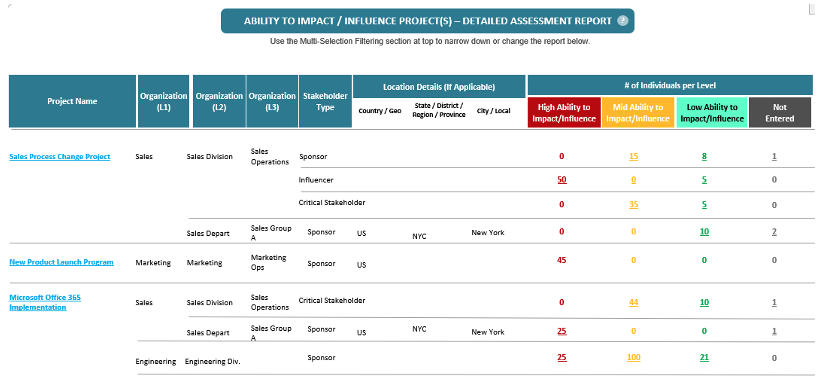
The AGS stakeholder management plan template system is an online change manager that is designed to help you plan, manage, and execute a successful stakeholder strategy and change project.
Choose from a Cloud or Excel version that includes real-time stakeholder plan analytics and stakeholder assessment samples, as well as simplified stakeholder templates for gathering your organizational stakeholder information and managing tasks.
AGS 360 allows you to easily segment your stakeholder groups and to quickly see which stakeholders are resisting the business change, and which ones are strong advocates of the change.
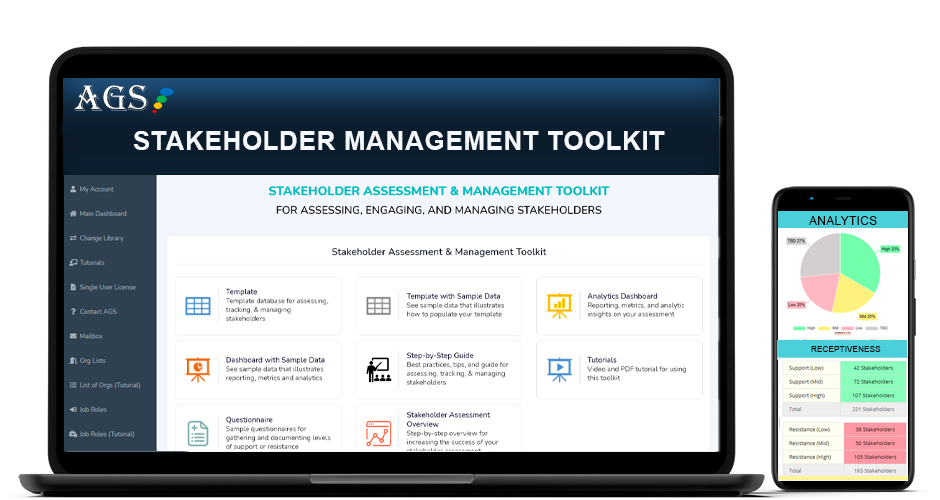
Stakeholder Management Framework Tool
If it hasn't been done already, as part of the change project, you should also conduct a change impact assessment which involves reviewing the current state process flows and the future state process flows to identify what is changing and who will be impacted.
From your change impact analysis, you should be able to identify a broader list of stakeholder groups, including primary, secondary, and critical stakeholders that need to be engaged and managed when implementing your stakeholder management framework.
Step 2. Stakeholder Assessment
The next step in your stakeholder engagement strategy, after gathering your list of stakeholders and stakeholder groups, will be to conduct an assessment of each stakeholder's desired commitment levels, the influence of the program, and other factors. And, then document this information in your AGS stakeholder matrix and mapping tool or another tool or sheet you've created.
Some of the information you'll collect during the assessment phase of your stakeholder management framework includes:
- Where each stakeholder stands on support for the change
- The level of influence/impact that stakeholders have on the change project
- The time availability of stakeholders for accomplishing change activities.
Why should you collect this information?
Support for the Change Project
As a change manager, project manager, or member of the change team, it's important for you to know where high and low support is within the organization. For stakeholders with low support, you will conduct certain types of engagement activities to identify reasons for low support and work to mitigate that resistance.
Your individualized engagement strategy will differ for stakeholders with high support for a project. For example, for those with high support and enthusiasm for the project, you may want to ask if they'd consider joining the Change Champions team or enlist their help in another way.
Ability to Influence/Impact the Project
Organizational groups and stakeholders with a higher ability to impact a project will typically be a higher priority for your stakeholder engagement framework and implementation than those with a lower ability to impact your project.
While you need to have an engagement strategy for all stakeholders, no matter their level of influence or impact, those that have a high ability to impact your project would be among those you want to address first.
Ability to impact incorporates things like: Can they change the budget or timeline? Can they cause other stakeholders to resist (or support) the project? Can they impact the project in another way?
This information will drive your engagement plan for each stakeholder. For example, if a stakeholder that can impact or halt a change is opposing the change, then you will need to implement a plan to gain that person's buy-in or to at least bring them down from a high resisting level to a low resisting level.
Don't Miss: Seamless stakeholder management plan template.
Time Availability
You can't assume that every stakeholder is going to have as much time as you'd like for their change engagement, coaching, training, and other change-related activities.
Some stakeholders may already be overwhelmed with their job duties, while others may have more time to devote to the change project. Knowing a stakeholder's time availability for needed and desired change activities can help you plan more strategically.
Knowing which stakeholders have low availability provides you with a "heads up" that you should find time-efficient ways to engage.
Additional Information
In addition to these KPIs, enter details on the stakeholder's current state situation. This will help you plan the stakeholder's engagement strategy. You'll include answers to questions such as:
- If the Stakeholder is resistant, what are their concerns?
- What is the stakeholder's experience with change (good or bad)?
- Is the Stakeholder a good candidate for taking on an additional support role?
- Does this Stakeholder have control over the project's budget or timeline?
- What else needs to be known about this Stakeholder?
These details on the stakeholder's current situation as it relates to the change project can be a valuable resource for planning your engagement activities.
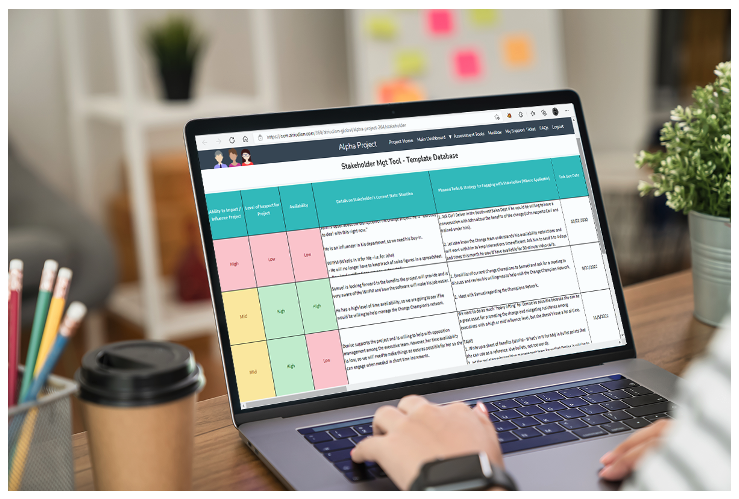
The AGS stakeholder management toolkit includes sample stakeholder management plans and examples that you can leverage for your needs.
Inputting Your Assessment Data
Enter all of this information into your AGS Stakeholder Management Toolkit's template which includes columns for capturing each individual's current level of support, level of influence, availability, and other important information including role, title, reporting structure, and current state situation.
Your stakeholder mapping template will be used to capture basic stakeholder information (part of step 1), and then step 2 will be used to document the level of each stakeholder's receptiveness or resistance to the project, as well as the change management approach for mitigating any identified resistance.
Don't Miss: Seamless stakeholder management plan template.
You should also gather information on who will be responsible for executing the engagement and management approach for each identified stakeholder. This will also need to be documented in your stakeholder engagement matrix template and integrated into your stakeholder plan.
Make sure to develop reporting stats and insights from your stakeholder identification and analysis. For example, the AGS Stakeholder Tool has an analytics dashboard that provides a holistic view of how many stakeholders have a high ability to impact the project versus their support for the project, among many other helpful reports.
Illustration: AGS Stakeholder Toolkit Reporting Dashboard
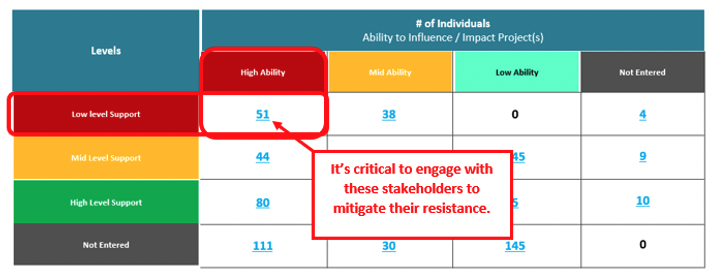
AGS Stakeholder Management Templates, Dashboard & Samples
Step 3. Stakeholder Engagement Strategy & Planning
Once you've documented the necessary details on each stakeholder as to their level of receptiveness to the project, ability to impact the project, time availability, and current state situation, you will formulate your engagement strategy.
There are two prongs to your engagement strategy planning:
- Individualized Engagement Activities
- Shared Engagement Activities
Let's break this down.
Stakeholder Plan: Individualized Engagement
Individualized engagement is related to that stakeholder's distinct current state situation and their attitude towards the change project.
Not all stakeholders are going to have the same thoughts and feelings about the change project. One may be excited and supportive, while another is dreading the change and actively trying to stop it.
For two such stakeholder types, you would have different individualized stakeholder engagement strategies.
If a stakeholder supports the project and is excited about it, then you may want to ask them to be part of the Change Champions network or provide additional support to the project in another way.
See Also: Stakeholder engagement plan samples and framework tool.
If a stakeholder is resistant to the project, then you'll need to formulate a completely different individualized strategy which involves identifying their reasons for resistance, putting together a listing of WIIFM (What's in it for me – meaning for the stakeholder), and finding someone they respect to help you speak with them and mitigate resistance.
Another example of your stakeholder plan individualized engagement is if you have some primary or critical stakeholders that are managers needed to provide leadership within their departments for the change. You may include coaching on change management best practices as part of their individualized engagement to give them needed guidance.
Stakeholder Plan: Shared Engagement
Shared engagement activities are those that need to happen regardless of a stakeholder's feelings about a change. This would include things like communications. You need to send a variety of project communications to all stakeholders throughout the change regardless of their individualized strategy.
Another type of your stakeholder plan shared engagement activity is training. If training on software or a new process is needed as part of a change initiative, then that's another engagement activity that would encompass all or most stakeholders.
There might be slight differences in the types of communications sent and training done for stakeholders based upon their job roles, departments, and other parameters. But, regardless, they would still need to be included in the engagement activity.
For individualized engagement, on the other hand, you would only be conducting resistance management for those stakeholders that did not support the project or had a low level of support. This would not be an activity that you would need to do for those stakeholders already in support of the change.
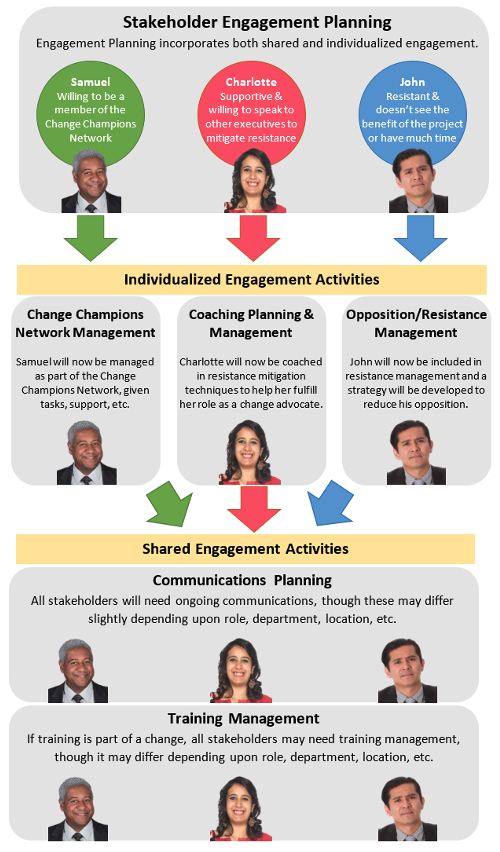
Don't Miss: Stakeholder engagement plan samples and framework tool. Also, contact us if you have any questions or feedback about this end-to-end guide.
Step 4: Implement Stakeholder Engagement Strategy
The next step in the stakeholder management process is stakeholder engagement. This is where you will execute the individualized and shared stakeholder engagement strategies that you developed in Step 3.
During the stakeholder engagement stage, you should conduct 1-on-1 meetings or group meetings with stakeholders to provide awareness, program status updates, and also to address any questions or concerns they might have (they often have some level of concerns).
For primary, critical, or secondary stakeholders that you identified as needing coaching and change management support, you should prepare and provide them with the necessary level of coaching and education to support them in their role as change agents for the program.
Your coaching plan should define how you will support managers and supervisors during the change.
Read more: Organizational Change Management Coaching Plan.
A key focus of your stakeholder engagement approach will be to fully enable primary and secondary stakeholders to:
1. Sponsor the change
2. Advocate for the change
3. Support their employees during the change
4. Communicate the change
5. Support their employees in the new, changed environment
6. Reduce resistance to the change
7. Overcome barriers and obstacles
For other stakeholders that are not in leadership positions, you'll be focusing their engagement on:
1. Change awareness
2. Advocate for the change
3. Support their colleagues during the change
4. Keep open lines of communication with the change management team
5. Support their colleagues in the new, changed environment
6. Overcome resistance to the change
7. Successfully sustain new, changed behaviors and processes
Task Management During Engagement
While you're going through your stakeholder engagement activities, there will be tasks that you assign to the change or project team members and the person engaging with the stakeholder.
You may also have stakeholder tasks that you assign the stakeholder. These tasks can encompass many types of activities, here are a few examples:
- Watch a video related to the benefits of the project.
- Fill out a questionnaire about the change impact.
- Meet with the coaching team to learn more about leadership's role during the change.
It's helpful to keep track of these stakeholder management tasks in the same template you're using for your change management stakeholder analysis and management. That way everything stays in one place and all team members can keep track of task due dates, assignees, and progress.
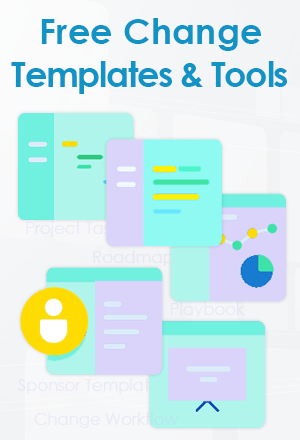
Illustration: AGS Stakeholder Engagement Framework Toolkit Incorporates 2 Task Management Panels
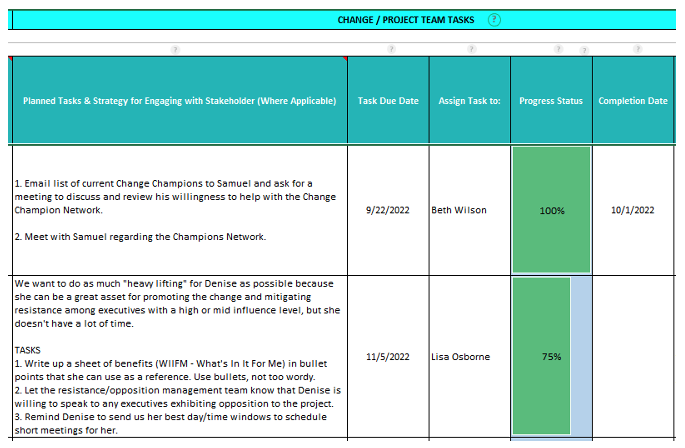
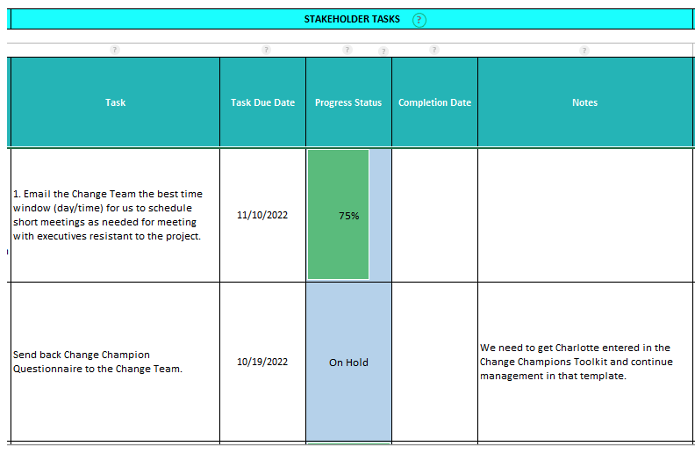
Is there a best stakeholder engagement plan template that you have used that you would like to share with other project managers and change leads? Please, reach out and let us know.
Step 5: Ongoing Stakeholder Management
The final step in the stakeholder engagement process will occur throughout the project life cycle. Until the project is completed, you will need to continually engage with stakeholders to provide regular status updates and to ensure that they continue to support the project.
Something to keep in mind is that your stakeholder management strategic plan should not be set in stone. For your stakeholder engagement framework to be flexible, your plan document needs to be a living document that will be updated regularly.
As the project progresses, individuals will switch roles and so might need to be removed from your list of stakeholders, and new individuals will need to be added. You will need to revisit and refine your stakeholder relationship management periodically as the project progresses and as more information is discovered.
Don't Miss: All-in-One Stakeholder Engagement Framework Toolkit.
Engagement Success Tracking
When reporting on stakeholder management engagement it's helpful to have an engagement success metric. This allows you to see how engagement is going and adjust as needed if you see low success scores.
It's important to track how the engagement process is going because it's an indicator of how your change project will progress. If you have too many stakeholders with "Missed Target" or "Low" on their engagement score, that's a warning sign that you need to change your engagement strategy or you could end up missing the mark on the entire project and falling short of expectations.
In your stakeholder management software or spreadsheet, use an area for designating a success score for engagement and include next to that metrics for that score.
You don't want the level of engagement success to be completely objective scoring. It's important to include specifics. Set clear and measurable goals. How will progress be measured?
Try to use quantitative measurements along with qualitative information for your levels where possible. Quantitative would be a hard number measurement of something, like how many meetings were attended. Qualitative is descriptive and more subjective, such as how positive a person is feeling about a project.
It's also better to have more than one measurement of each success level. This provides a more robust set of KPIs that cover multiple angles and reduces the risk of stakeholder engagement success is based upon just one person's opinion.
Illustration: Example of AGS 360's Stakeholder Engagement Success Tracking
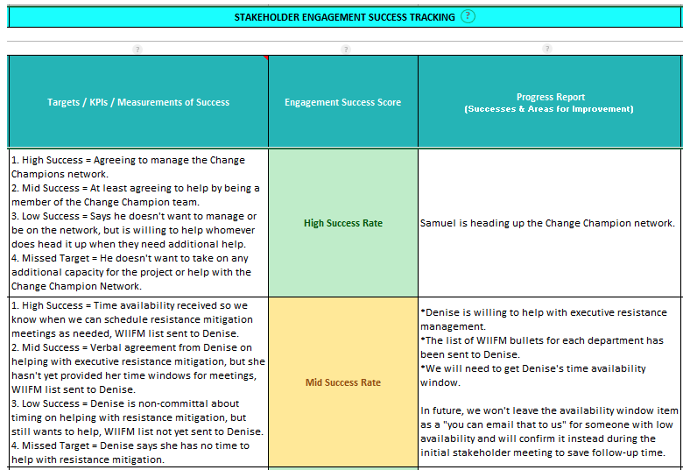
Possible ways to measure engagement success:
- Use the Level of Support column as a measure of success. For example, if a stakeholder is moved from a "Low" level of project support to a "High" level of support.
- Has the obstacle or reason for resistance been overcome?
- Have you received the needed items from the stakeholder (e.g., survey response or job duties summary)?
- Has the stakeholder stopped exhibiting behavior detrimental to the project (i.e., spouting off negative things about the change to others, etc.)?
- How many scheduled meetings has the stakeholder attended?
- How many given tasks has the stakeholder completed?

Stakeholder Management Tool
Types & Role of Stakeholders in Project Management
For project management and organizational change management purposes, there are different types of stakeholders in project management that need to be identified, engaged, and managed for a project to be successful. These include primary stakeholders, internal and external stakeholders, critical managers, key stakeholders, and other stakeholder groups defined below.
You should separate your stakeholders by type, otherwise planning engagement is going to take you a lot more time, because whenever you look at your list of stakeholders, you'll need to remember whether they're a change agent, executive, manager, etc.
Some types of stakeholders in project management may have a different engagement plan or change impact than others. For example, if someone is a stakeholder type "Executive" you may need to provide slightly different communications to them than you would a stakeholder that is a "Department Head."
Designating each person's stakeholder type makes it easy to sort and filter your stakeholders as you're doing your analysis and planning engagement.
How many stakeholder types should be used?
Having too many stakeholder types is not ideal for a project because it can become difficult to manage too many types. It is recommended that you only have 5 to 10 stakeholder types at the maximum.
Primary Stakeholder (Definition)
Primary stakeholders are managers, senior managers, executives, heads of departments, or business leaders that have a "stake" in the game because their department or organization will be impacted in some way by the change. Primary stakeholders are also referred to as key stakeholders because of their ability to hinder or promote the project.
You may decide to break your primary sponsors out into each distinct position (Executive, Department Head, etc.) or group them under "Leadership." Ask yourself whether you need to engage or communicate with your primary stakeholders differently or not depending on their position. The answer will indicate whether you want to break these out into their own types or just keep them grouped under a general primary stakeholder type designation.
Project Sponsor (Definition)
Project sponsors are managers or leaders that are tasked with approving and being responsible for the overall success of the completion of a project. These individuals are generally the ones that approve the budget for the project and sign off on the project getting kicked off. This role involves approving the allocation of resources, approving project goals & objectives, and approving the implementation roadmap. A project sponsor is also referred to as an executive sponsor.
Critical Stakeholders (Definition)
A critical stakeholder is any internal stakeholder that is absolutely needed to be a sponsor or an advocate of the program for the program to succeed. Critical stakeholders are often powerful or highly influential managers within the organization who will be impacted by the program. They may or may not be sponsors at this point.
As part of your stakeholder management plan, you will need to identify these influential internal stakeholders and engage them to ensure that they are supportive of the change.
Influencer (Definition)
This is a stakeholder that holds influence over their peers. They could be overachievers that others look to for leadership or someone that everyone likes and turns to for advice. Others can be swayed towards support or resistance of the project by this person.
Change Agent/Champion (Definition)
A Change Agent or Change Champion is any individual who is part of a group that will be impacted by a change, and who is willing to engage their colleagues to increase awareness, acceptance, and adoption of the change. Change agents and change champions play a key role in transformational change because they can facilitate change at the individual level within their organizations.
Steering Committee Member (Definition)
A steering committee is a group of people, usually managers, that oversee and support a project. This designation can be used for any employees, managers, or executives, and other critical stakeholders with the special designation of being a part of the project's steering committee.
Impacted End User (Definition)
For any other stakeholder, including employees that are not in leadership, you can use the impacted end-user stakeholder type. This indicates an end-user that is impacted by the change project.
See below for other types of stakeholders in project management.
Internal & External Stakeholders (Definition)
A change project can include both internal and external stakeholders. It's important to separate these groups when creating or using your stakeholder engagement spreadsheet or template because engagement activities can vary significantly. One group is internal to your organization and the other is not.
Internal Stakeholders (Definition)
Internal stakeholders are groups and individuals that are part of the company's organizational structure and that are being impacted by the change. They are employees, managers, and leaders that are employed by the company.
External Stakeholders (Definition)
External stakeholders are groups and individuals that are NOT part of the company's organizational structure. They include customers, clients, suppliers, vendors, and other partners that will be impacted directly or indirectly by the change project.
See also: stakeholder management examples, templates, tools.
What Else Should You Know About Managing Stakeholders?
Stakeholders vs Project Sponsors
Change projects include both stakeholders and sponsors. Let us quickly discuss stakeholders vs. sponsors , as these two related groups of individuals will make up your stakeholder target audience and are often confused by program managers and project leads.
As mentioned above, stakeholders are managers, heads of departments, business leaders, employees, and external groups that have a "stake" in the game because their department or organization will be impacted in some way by the change, while a project sponsor is a manager or leader that is willing to sponsor a change or someone who has been mandated by the organization's leaders to sponsor a change.
A sponsor may also be a stakeholder. However, a stakeholder may or may not be a sponsor of the change (and may not be supportive of the change at this point).
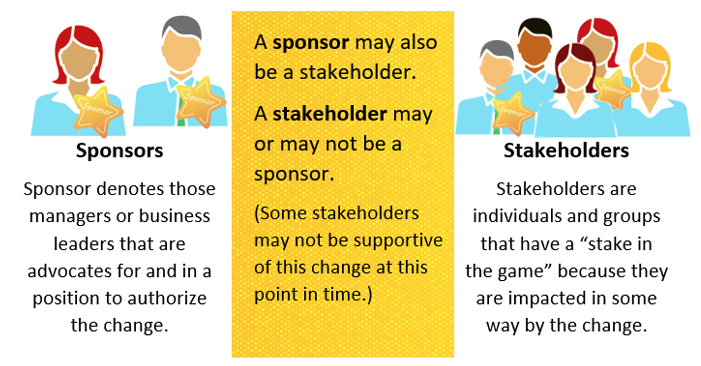
Don't miss: Get your stakeholder engagement template and start conducting your analysis today.
Different Levels of Sponsorship
There are different levels of program management sponsorship. A sponsor might simply be responsible for approving and managing the budget for a project as well as overseeing the overall success of the initiative. This type of sponsor is often referred to as the primary sponsor.
Other sponsors might solely be responsible for helping to spread awareness about the change and helping to overcome roadblocks within their group. Another type of stakeholder sponsor is a leader that is willing to support the change program by engaging other senior leaders to solicit buy-in for the change and helping to reduce resistance. These are commonly referred to as secondary sponsors.
Sponsors generally wear different hats and manage different responsibilities.
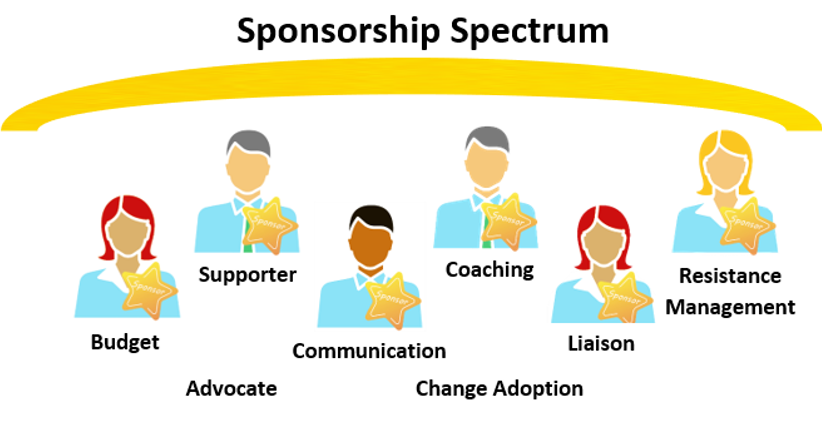
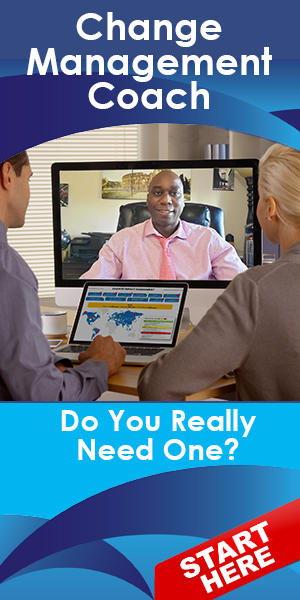
Do you have any questions about the stakeholder engagement strategy template? Please reach out and let us know.
Conclusion
We hope this end-to-end stakeholder management guide has helped in answering the key questions you might have had regarding stakeholders of a change project, including:
- What is stakeholder management?
- Who are stakeholders in a project?
- What are the best ways to create a stakeholder plan?
- Why are stakeholders important?
- Why is stakeholder engagement important?
- What is stakeholder engagement meaning?
- What is the role of stakeholders in project management?
- How do you plan stakeholder engagement?
As discussed above, a stakeholder engagement plan needs to be developed for your project because it is a foundational element of your change management activities. Your stakeholder engagement plan will be used to build commitment (sponsorship and support of the program) from key individuals across impacted groups or target audiences.
Developing your stakeholder engagement strategy and plan will help ensure consistency, and a deliberate engagement with sponsors, primary, secondary, internal, and external stakeholders.
To effectively support a project, these stakeholder groups need regular communication to keep them in the loop, as well as coaching on best change management practices to help them perform their roles as agents of the change.
Do you have more examples of the role of stakeholders in project management that you would like included in this guide? Contact us and let us know.
Stakeholder Management Made Easy
The AGS Stakeholder Assessment & Management Tool includes a best-in-class stakeholder management template, samples, a 360-degree analytics view of impacted groups, and much more for stakeholder engagement in project management.
AGS Cloud is a full-featured cloud platform to help you plan, manage, and execute a successful change project, end-to-end, whether this is your first change project or your one-hundredth. You can choose from several toolkits in the platform or just choose the Stakeholder Management Toolkit.
Getting Started with AGS Toolkits
If you subscribe to one or more AGS Toolkits including the AGS toolkit for conducting stakeholder engagement in project management, here's how you get started!
Once you've subscribed, you'll sign in and be taken to the 360° Main Dashboard page. To begin using your Toolkit(s), you would follow these steps:
- Create a new project.
- Name your project.
- Add additional project members (if you wish).
- Check the box(es) to enable your purchased or free AGS Toolkit(s) for that project.
- Save your project.
- Click to go to the Home Page of your project.
- Your AGS Toolkits will be there on the Project Home Page waiting for you to dive in!
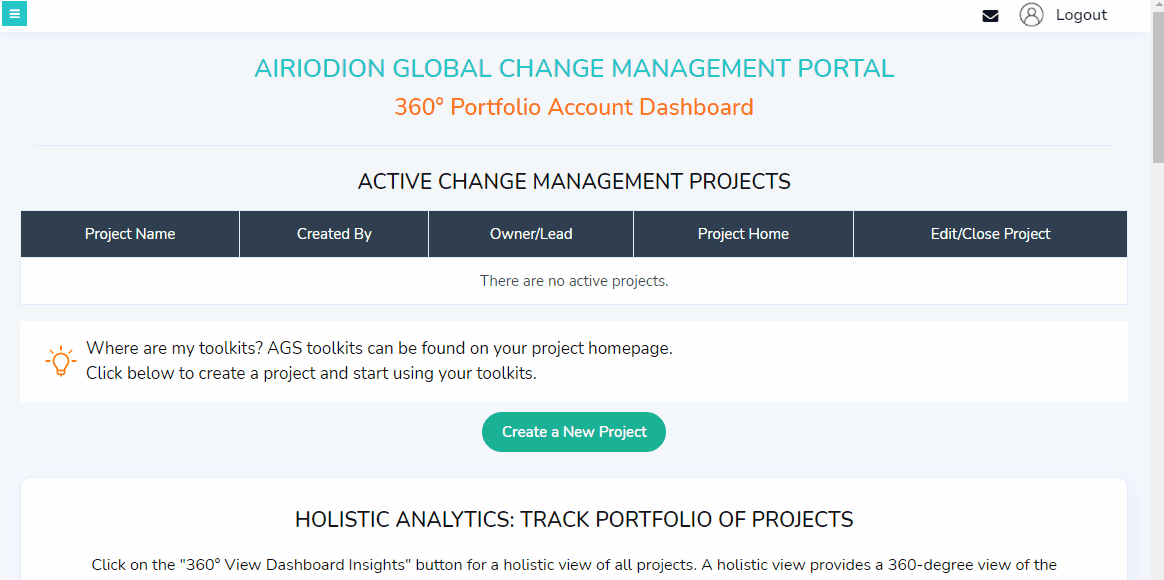
Get Your Copy of the AGS Toolkit for Stakeholder Engagement in Project Management! 
Stakeholder Mapping Templates and Tools
Why is stakeholder management important?
Stakeholder management is the set of tasks that you perform to identify and manage stakeholder groups, including the primary and secondary stakeholders that have a stake in a project or business transformation. Stakeholder management is very important because if stakeholders do not support a change, or if they resist the change, then the project will likely fail.
Why is stakeholder engagement important?
Stakeholder engagement is the process of engaging with stakeholders to get their buy-in and support for a change. If stakeholders resist a change, the probability of success for the change is reduced, and the initiative might actually fail. As such, stakeholders must be engaged before and during the change implementation.
What is stakeholder engagement and why is it important?
Stakeholder management is one of the most critical areas of project and change management. Without stakeholder buy-in and support of a change, the probability of success for the change is reduced, and the project might actually fail. As such, stakeholders must be engaged throughout the duration of the project.
How do you manage stakeholder engagement?
The process of managing stakeholders for project or initiative begins with identifying which stakeholders are being impacted by a change project and also understanding whether each stakeholder is receptive to or resisting the change. Then you want to develop a similar stakeholder management plan outlined on this page.
What are the benefits of stakeholder engagement? And why are stakeholders so important?
Stakeholders are very important because they are in a position to increase, block, or decrease the success of the project. If stakeholder groups are resistant to the change, this will have a negative impact on the implementation of the project. If, on the other hand, they are very supportive of the change, then the probability of project success is greatly increased.
Note: Content on OCM Solution (Formerly Airiodion Global Services (AGS))'s ocmsolution.com website is copyrighted. If you have questions, comments, or tips about this OCM Solution (Formerly Airiodion Global Services) content or product, please contact OCM Solution today.
External Sources: https://stock.adobe.com, https://pixabay.com/illustrations/businessman-team-spirit-teamwork-1492563/ and https://pixabay.com/photos/office-business-colleagues-meeting-1209640/, https://www.ls.graphics/free/free-pixel-4-and-pixelbook-go-mockup, https://www.pexels.com/photo/woman-wearing-gray-shirt-3184298/
gilliardcongavoke41.blogspot.com
Source: https://www.ocmsolution.com/stakeholder-management/
0 Response to "System You Will Use to Continuously Collect Stakeholder Concerns and Recommendations"
Postar um comentário